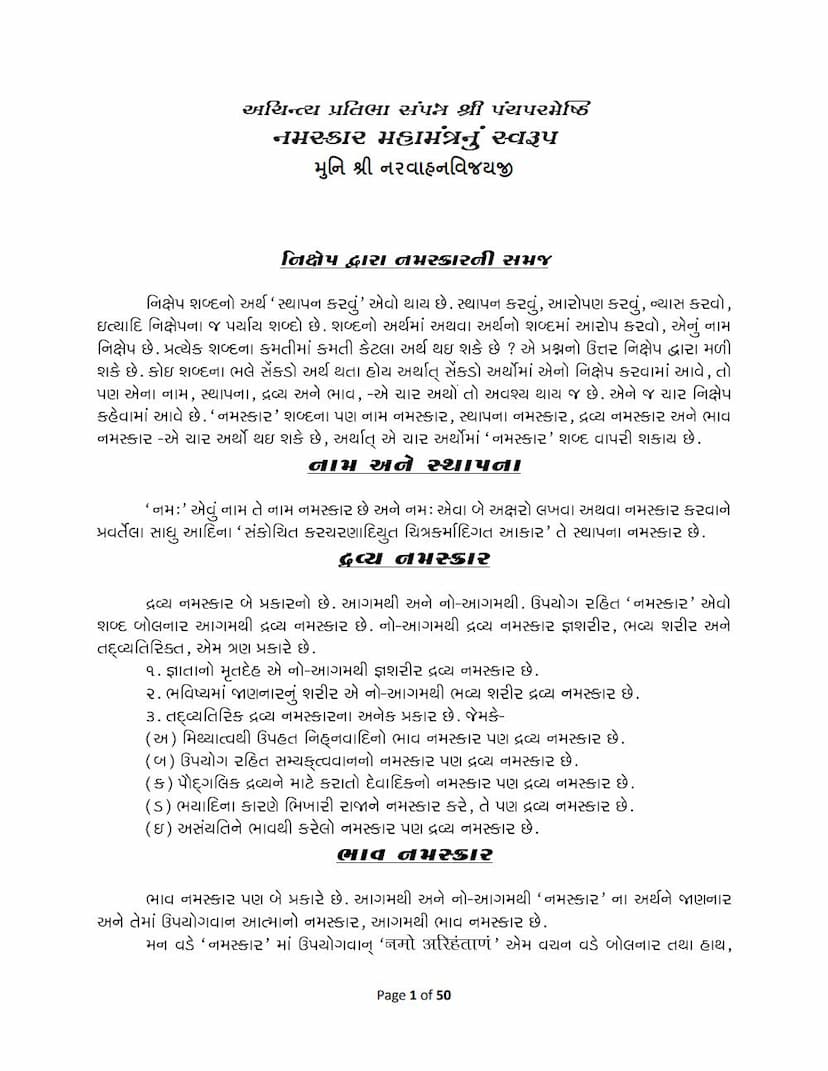Namaskar Mahamantranu Swarup Part 02
Added to library: September 2, 2025

Summary
This document is a detailed explanation of the Namaskar Mahamantra in Jainism, also known as the Navkar Mantra. The book, "Namaskar Mahamantra Swarup Part 02" by Narvahanvijay, delves into the profound meaning and significance of this sacred chant, which is central to Jain practice.
The text begins by explaining the concept of 'Nikshep' (classification) as a method to understand any word or concept, including the Namaskar Mahamantra. It outlines four types of Nikshep:
- Nam Nikshep: The literal name, such as "Namah" (meaning salutation).
- Sthapna Nikshep: Symbolic representations, like writing the word "Namah" or depictions of holy figures that inspire the act of salutation.
- Dravya Nikshep: Material or physical forms of salutation, which can be further divided into:
- Agam Dravya Nikshep: Speaking the word "Namaskar" without current mindfulness.
- No-Agam Dravya Nikshep: This includes the dead body of a knowledgeable person, the future body of someone knowledgeable, and other categories like salutations made out of delusion, salutations by a righteous person without full mindfulness, salutations to deities by non-Jains, and salutations made out of fear.
- Bhava Nikshep: The internal state of reverence and mindfulness. This is also divided into:
- Agam Bhava Nikshep: Understanding the meaning of "Namaskar" and being mindful of it.
- No-Agam Bhava Nikshep: A combination of mindfulness (Agam) and the physical actions of bowing or saluting (which is considered 'Agam-abhav' or lacking the full essence of mindfulness).
The book then details the traditional method of initiating the recitation of the Navkar mantra, often involving a period of fasting and specific rituals for young children. It emphasizes the importance of cultivating virtues like forgiveness, control of senses, and equanimity for those who wish to chant the mantra.
A significant portion of the text is dedicated to explaining the qualities required for a true aspirant and those who chant the Navkar mantra. These include:
- Shant-Samta (Peace and Equanimity): Understanding that attachment to favorable things and aversion to unfavorable things leads to unrest and the cycle of birth and death. True peace comes from detachment.
- Dant (Control of Senses): The ability to withdraw senses from desirable or undesirable objects.
- Guna-Maya Daya (Virtuous Compassion): True compassion begins with self-compassion, understanding one's own origin and potential future, and extends to all beings, recognizing their desire for happiness and aversion to suffering.
- Paropkar (Altruism): Helping others overcome suffering and attain happiness, ideally without selfish motives. This is explained through three stages: being saddened by others' sorrow, being happy by others' happiness, and even enduring one's own suffering to bring happiness to others.
- Seva of Saints: Serving holy beings with reverence and devotion.
- Control of Passions (Vishay-Kashay): Overcoming desires and negative emotions like anger, pride, deceit, and greed.
- Right Thinking (Suvichari): Constantly engaging in virtuous thoughts and remembering the teachings of the learned.
- Swayadvada (Relativism): An open-minded approach, accepting multiple perspectives without firm attachment.
- Samata Rasa (Essence of Equanimity): The ability to remain balanced amidst pleasure and pain.
The text then elaborates on the structure and significance of the Navkar mantra itself, noting it has 68 letters and 9 'padas' (terms). It discusses the eight 'sampadas' (resting places or significant points) within the mantra.
A large section is devoted to detailing the qualities and significance of each of the five Supreme Beings (Panch Parmeshthi) to whom the mantra is offered:
- Arihant: Their qualities are described extensively, including their 12 inherent perfections (8 Pratiharyas and 4 Atishayas), 35 types of speech, and various epithets and descriptions emphasizing their liberation from worldly afflictions and their role as spiritual guides.
- Siddha: Their state of eternal liberation and their eight fundamental qualities that arise from the destruction of eight karmas (infinite knowledge, perception, bliss, energy, formlessness, imponderability, imperishability, and unimpededness).
- Acharya: The spiritual leaders who guide the Jain Sangha, emphasizing their 36 qualities encompassing knowledge, conduct, penance, and devotion.
- Upadhyaya: The teachers who impart spiritual knowledge, highlighting their 25 qualities related to mastering the 11 Angas and 12 Upangas of Jain scripture.
- Sadhu: The monks and nuns who have renounced worldly life, detailing their various virtues and the importance of their role as living embodiments of the teachings.
The book also provides extensive explanations of the origin and etymology of the terms used for each Parmeshthi, drawing from various Jain scriptures and philosophical concepts. It stresses that the Navkar mantra is the root of all auspiciousness, the essence of the Jain religion, and holds immense spiritual power.
Finally, the text concludes with the profound benefits of chanting the Navkar mantra, such as the destruction of sins, attainment of auspiciousness, and ultimately, the path to liberation. It encourages constant remembrance and practice of the mantra, emphasizing the need for right intention and sincere devotion.